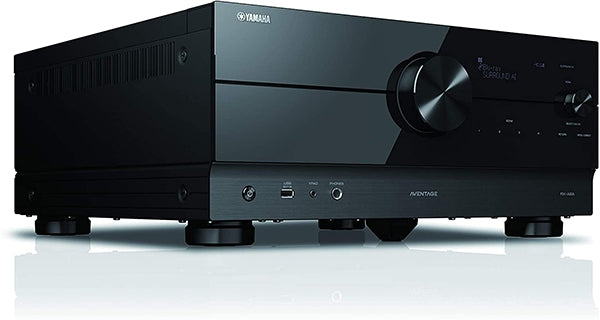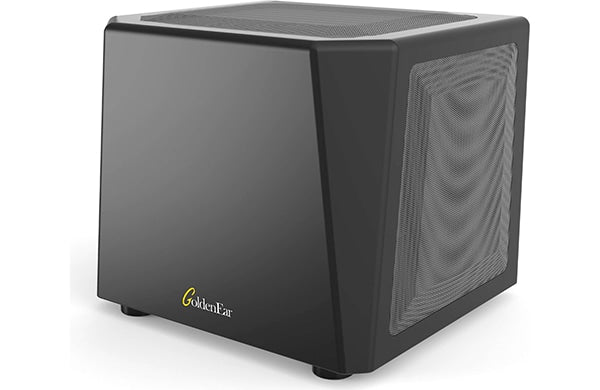One area where this can perhaps be easily notable is if you are watching an old black and white film that was originally recorded in mono, and may have been subjected to some remastering to try and enhance some of the details in the sonic spectrum, particularly in the vocals. The soundtrack may have added reverbs or processing to widen out the spatial quality of the recording. You may often notice that the vocal tracks have been boosted to give them more lift and punch in the overall mix.
Setting your main speakers to “small” will tend to give that vocal clarity its cleanest separation, as the frequency range of vocals is largely in the midrange, and the main speakers will be free to reproduce these vocal frequencies, while the bottom end is handled by the subwoofer rather than the main speakers. You may in fact find that some older film soundtracks can be a bit shrill in their upper mids, but nonetheless, I think you’ll be able to easily appreciate the difference when changing between speaker size settings of “large” and “small” it can become a good mental reference point.
When it comes to using movie soundtracks, though, one problem is that we simply don’t know which channels the bass has been mixed to. Some bass may have been assigned to the surround speakers, the fronts or even the center channel, particularly if the action is happening center-screen, or in the relative positions of where the action is taking place. Also, Dolby Digital soundtracks have a dedicated LFE or low-frequency effects channel. We weren’t there when the film was mixed and mastered, so what can we do if we find that a lot of the movies and music we listen to are perhaps lacking in the vocal punch and presence we wish to hear? Again, this is another good reason to set your main speakers to “small,” so that they are free to reproduce that frequency range more readily and without being overshadowed by overlapping lower bass frequencies.
 NAD receiver speaker setup screen.
NAD receiver speaker setup screen.Some A/V receivers and preamp/processors, such as the Yamaha receiver I own, actually have both a vocal level and a “lift” setting so you can manually boost either to taste. The level controls up to three volume levels. If vocal sounds cannot be heard clearly, you can turn up their volume by increasing this setting from “one” to “three.” The lift is adjustable from “one” to “five” and alters the perceived height of the dialogue sounds; the bigger the value, the higher the position. (This may be more pertinent for adjusting the vocals when watching a film if they sound like they are coming from too far below the TV.) The lift function comes into available operation when using one of the Yamaha’s surround-sound programs that accommodate presence speakers, or when Virtual Presence Speakers is turned on, but not when in 2-channel stereo or “7-channel stereo” modes. This can be very useful when trying to get the best sound “on the fly” for the varying audio qualities of TV broadcasts, most of which have been subject to all manner of compression.
For these reasons and those mentioned in our previous installment, many subwoofer manufacturers will extol the virtues of setting your main speakers to “small,” and also because they want to sell you subwoofers. And that’s fine. They may point out the reality that running your speakers full-range can also put huge dynamic power demands on your A/V receiver, causing it to get hot. Also, in the case of physically small speakers, such as bookshelf monitors and/or speakers with smaller woofers (around 8-inches in diameter or less) that are limited in bass extension, it makes sense to set the speaker setup to “small.”
 11.2 channels of whack: the Yamaha Aventage RX-A8A receiver.
11.2 channels of whack: the Yamaha Aventage RX-A8A receiver.In our last installment, though, we suggested that there was a good case for running speakers full-range, with the receiver or preamp/processor’s speaker setup set to “large,” but also using a subwoofer at the same time. Why?
The first reason is that many speakers are capable of producing a lot of bass, and to crop off their production of it at around 80 Hz is basically handicapping the speakers’ output and the tonal character the designer had in mind. It’s true, the main speakers, even if they’re floorstanding towers, may struggle to get below, say, 25 Hz or even much higher, but setting your subwoofer crossover at 80 Hz and your speaker to the “small setting” potentially leaves a frequency range gap (in this example) of up to 55 Hz that the main speakers could potentially deliver down to. Is this really what you want to do?
It’s worth mentioning that many A/V receivers and processors sound better when they are warmed up, and are capable of running hot quite safely, given adequate ventilation as per the manufacturer’s guidelines.
As a case in point, I have recently changed my upright, open multi-shelf wood and glass rack unit to a closed-cabinet glass-fronted horizontal design, and although I can operate the controls perfectly via the remote through the glass, I choose to open the front of the cabinet door to allow for good air circulation. I don’t mind the unit running within its specified operating temperatures, but equally, I don’t want to unnecessarily shorten its lifespan by cooking it for hours at a time. Yes, the equipment runs a little hotter than it used to. (Incidentally it has also saved me some space in my listening room, which is a welcome bonus, and still allows me space for changing power amps.)
If you decide to run your speakers full-range, you potentially avoid the handicap frequency gap we just mentioned, (the size of which will vary according to what your speakers are actually delivering and what you set your crossover to), but by also using a subwoofer, you plug a further more common frequency range gap of about 40 Hz down to 20Hz. In this situation, your main speakers are running at their optimal frequency range and tonal balance, with a dedicated subwoofer to consistent and solid bass up to the crossover point that you choose for sonic preference. Equally important, you can adjust the balance between the main speakers and subwoofer to accommodate for the room’s influence over your sound. Keep in mind that the room may influence your sound from a significant 50 to as much as 70 percent.
This too is important, because running your speakers full-range with a sub means that more locations in the room are generating lower bass frequencies, which may more readily compensate for the null points in the room where bass frequencies cancel out. I am personally running a quadraphonic (four-tower) system with one sub, and for music listening, this supportive bass envelopment from multiple locations makes for a richer and more fulfilling sound throughout, as more nulls have been quashed.
If you do decide you would like to set up your system this way or just integrate a subwoofer, it’s important to check that your speakers are operating in phase with the sub. Most subwoofers come with a phase switch allowing it to be set to either 0 or 180 degrees, or perhaps a dial to allow you to select in between those two options. Getting the subwoofer phase-correct with the main speakers is essential for achieving the most natural, full sounding, and cohesively integrated bass.
A bulletproof way of visualizing the effect of the sub’s phase is by measuring its response within Room EQ Wizard. When measuring this, you will be able to see either a trough, or the opposite, a fuller frequency response according to the phase you set. Although you can also listen for it, taking room readings gives you greater insight and specificity when making before and after adjustments, particularly for smoother integration with your speakers’ in-room frequency response.
This is just part of the process of integrating your subwoofer along with other procedures for setting up your system speakers, such as compensating for their distance from the listening position (delay time), and setting volume levels for each. Similarly with your sub, once you have set its position, distance and now phase correctly, you may then finely adjust he volume to further blend its frequency response in with the curve of the rest of the room, and eradicate any unwanted residual frequency troughs which may still remain. You may of course need to turn your sub volume down if the resultant measurement revealed too much of a peak! Either way, it’s good to remember that if you intend to further EQ your room’s response, it’s much easier to remove an unwanted peak rather than fill in a trough.
 You want bass? The GoldenEar SuperSub XXL subwoofer delivers it down to 10 Hz!
You want bass? The GoldenEar SuperSub XXL subwoofer delivers it down to 10 Hz!Another advantage I have found is that by running the speakers full-range, and properly integrating the bass from the subwoofer with the main speakers, is that because the bass volume has now naturally increased by about 5 dB, and is smoother across the lower frequencies, I can choose to turn up the bass further still, but without it sounding artificial or imbalanced due to peaks and troughs in the low-frequency response. This means I can run the system at different volume levels and still get a great sound. It’s particularly advantageous if I want to listen to music late into the night, albeit at lower volumes, without disturbing the neighbors’ sleep. (Well – I haven’t had any complaints so far!) Then, during the day, I can just turn up the volume to taste and continue to get that full and well-integrated sound.
Sometimes, though, I may turn the speaker setting back to “small” to listen to movies or documentaries that are heavy on dialogue, because of the increase in clarity discussed earlier. Also, in action movies and other material, the dynamics can be very dramatic and even overpowering with only the LFE channel handling the super low bass and explosive sounds. But, overall, I much prefer the way my system sounds with the “large” setting and the main speakers running full-range, for its timbre, depth, richness, musicality and more evenly -balanced bass response throughout the room. There is so much music present in movie soundtracks that I tend to leave the system set this way – and it’s optimal for me for pure music listening.
Header image: KEF KC62 subwoofer and LS50 Wireless II speakers.

0 comments